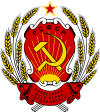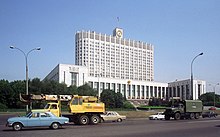Supreme_Soviet_of_the_RSFSR
Supreme Soviet of Russia
Supreme government institution of Russian SFSR
The Supreme Soviet of the Russian SFSR (Russian: Верховный Совет РСФСР, Verkhovny Sovet RSFSR), later Supreme Soviet of the Russian Federation (Russian: Верховный Совет Российской Федерации, Verkhovny Sovet Rossiyskoy Federatsii), was the supreme government institution of the Russian SFSR in 1938–1990; in 1990–1993 it was a permanent legislature (parliament), elected by the Congress of People's Deputies of the Russian Federation.[1]
This article has multiple issues. Please help improve it or discuss these issues on the talk page. (Learn how and when to remove these template messages)
|
The Supreme Soviet of the Russian SFSR was established to be similar in structure to the Supreme Soviet of the USSR in 1938, instead of the All-Russian Congress of Soviets as the highest organ of power of Russia.
In the 1940s, the Supreme Soviet Presidium and the Council of Ministers of the Russian SFSR were located in the former mansion of counts Osterman (3 Delegatskaya Street),[2][3] which was later in 1991 given to a museum. The sessions were held in Grand Kremlin Palace. In 1981 the Supreme Soviet was moved to a specially constructed building on Krasnopresnenskaya embankment, The House of Soviets.
The Supreme Soviet was abolished in October 1993 (after the events of Russia's 1993 constitutional crisis) and replaced by the Federal Assembly of Russia (consists of the Federation Council of Russia and State Duma).


